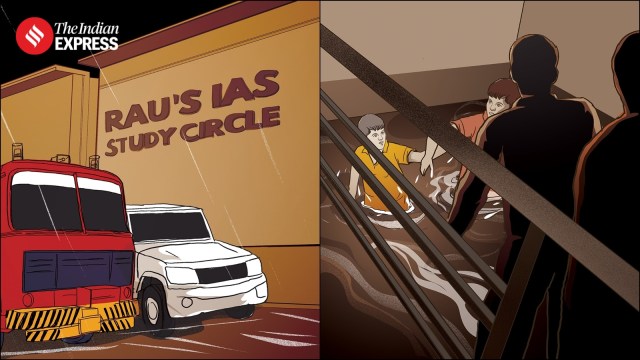
UPSC coaching center flood
Deaths: How the Basement Flooded and What Happened Next
The tragic flooding of Rau’s IAS Study Circle in Delhi’s Old Rajinder Nagar on Saturday led to the deaths of three UPSC aspirants and sparked outrage across the nation. The incident saw the Aam Aadmi Party (AAP) and the Bharatiya Janata Party (BJP) engage in a blame game, highlighting broader concerns about urban planning and safety in the city. Here’s a detailed account of what happened.
The Flooding Incident
On Saturday evening, heavy rains caused severe waterlogging in Old Rajinder Nagar. At around 6.45 pm, the gate of Rau’s IAS Study Circle broke, and water began to rush into the building’s basement, which housed around 20-25 students at the time. The closest weather station, PUSA, recorded 31.5 mm of rain between 5.30 pm and 8.30 pm.
Immediate Response
As water rapidly filled the basement, approximately 15 students managed to escape, while security guards on the upper floor cut the power supply to prevent electrocution. Despite these efforts, three or four students remained trapped. By 7 pm, water levels had reached the road surface. Delhi Police and fire department teams arrived with pumps to start draining the basement, joined by an additional pump from the Municipal Corporation of Delhi (MCD).
Rescue Operations
Deputy Commissioner of Police (DCP) Central M Harsha Vardhan described the rapid flooding and the immediate actions taken: “We received a call at 7 pm regarding the flooding and trapped individuals. Heavy rains caused significant waterlogging, leading to the quick flooding of the basement.”
About an hour after the flooding began, the National Disaster Response Force (NDRF) divers were called to assist in evacuating the remaining students. Tragically, the bodies of Shreya Yadav, Tanya Soni, and Nivin Dalwin were recovered during the operation. Early Sunday, the Delhi Police registered a criminal case after completing the search and rescue efforts.
Aftermath and Investigations
In response to the incident, the MCD sealed 13 coaching centers operating illegally in basements. A high-level committee was set up to investigate the flooding. Reports revealed that complaints about the illegal use of the basement had been filed with the MCD a month before the incident, with reminders sent on July 15 and July 22.
Protests and Political Reactions
The deaths led to protests by students in Old Rajinder Nagar, with AAP MP Swati Maliwal joining the demonstrations but facing backlash from the students who accused her of politicizing the tragedy. Protesters blocked roads near Karol Bagh Metro Station, leading to significant traffic disruptions and police intervention. Eyewitnesses and protesters claimed that the building’s biometric access system trapped students inside during the power outage.
Official Responses and Arrests
Lieutenant Governor V K Saxena criticized the incident as indicative of broader governance failures in Delhi over the past decade. He directed Divisional Commissioner Manish Kumar Gupta to submit a detailed report by Tuesday. The National Commission for Women (NCW) summoned AAP MLA from Rajinder Nagar, Durgesh Pathak, over the incident.
By Monday, Delhi Police had arrested seven individuals, including the basement owner and Rau’s IAS Study Circle’s Chief Executive Officer (CEO).
Conclusion
The tragic deaths of three UPSC aspirants in the flooded basement of Rau’s IAS Study Circle underscore serious issues in urban safety and regulatory enforcement. As investigations continue, the incident has sparked a significant public outcry and calls for stricter safety measures in educational institutions.
A video that surfaced online shows a powerful surge of water entering the basement, which was being used as a library in violation of regulations. The footage captures a vehicle driving through the waterlogged road outside the institute, splashing water onto its gate. Subsequently, the video reveals the gate appearing to collapse under the intense flow, allowing the water to flood the basement.
New Governors Appointed for 9 States



